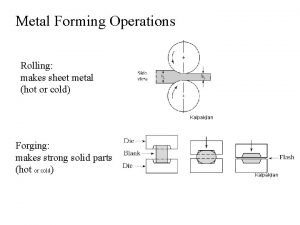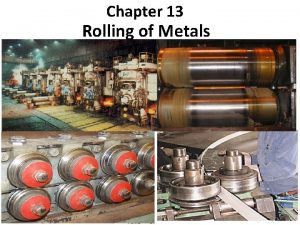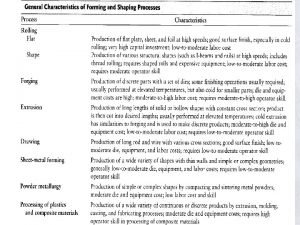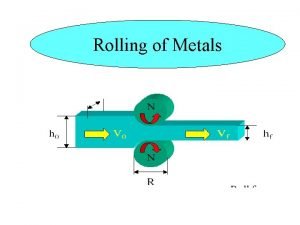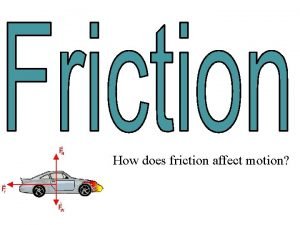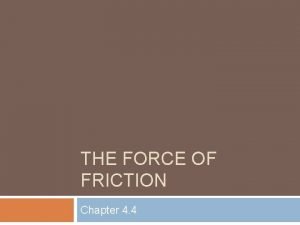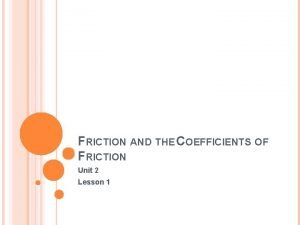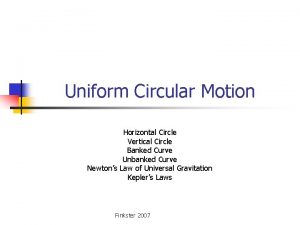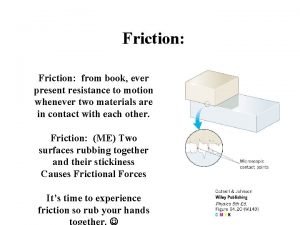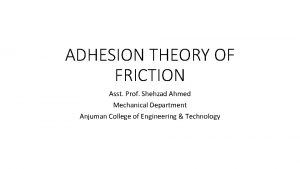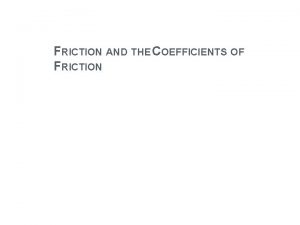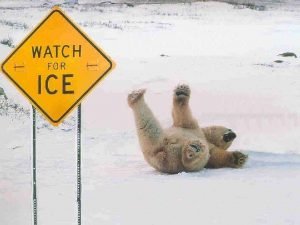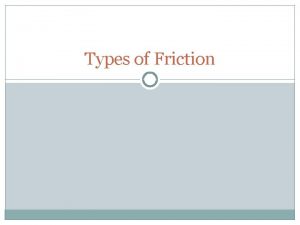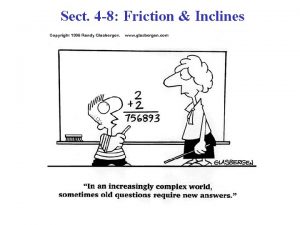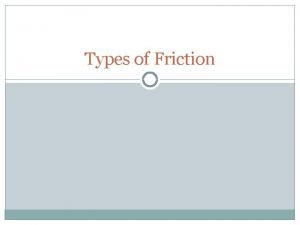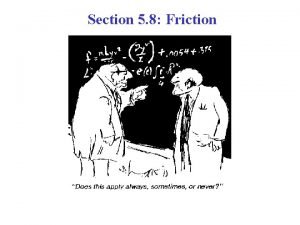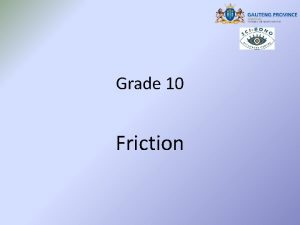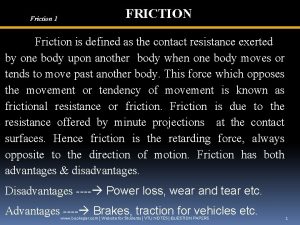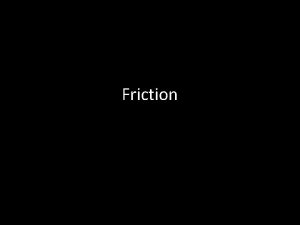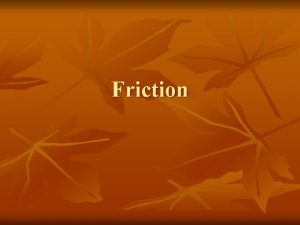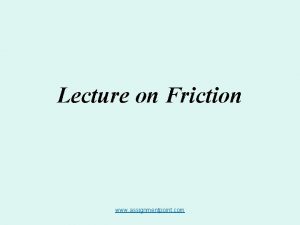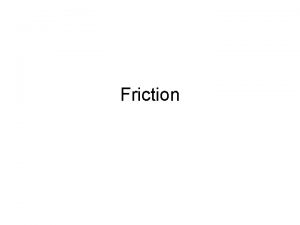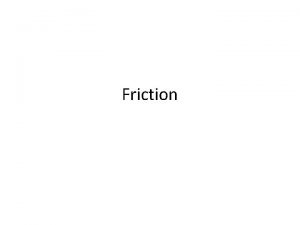Rolling Static friction f causes rolling It is

























- Slides: 25

Rolling • Static friction f causes rolling. It is an unknown, so we must solve for it. • First consider the free body diagram of the object and use FNET = Macm : In the x direction Mg sin - f = Macm • Now consider rotation about the CM and use = I realizing that = Rf and acm = R Lecture 14 Purdue University, Physics 220 M y f R x Mg 1

Rolling • We have two equations: Mg sin - f = Macm • We can combine these to eliminate f: I For a sphere: a M R Lecture 14 Purdue University, Physics 220 2

PHYSICS 220 Lecture 15 Angular Momentum Lecture 15 Purdue University, Physics 220 3

Linear vs Angular Displacement Velocity Acceleration Linear x v a Angular Inertia m I KE ½ m v 2 N 2 L F = ma = I Momentum p = mv L = I F t = p t = L change Lecture 15 Purdue University, Physics 220 ½ I 2 4

Define Angular Momentum p = mv L = I conserved if Fext = 0 conserved if ext = 0 Vector units: kg*m/s units: kg*m 2/s For a particle: Lecture 15 Purdue University, Physics 220 5

Right Hand Rule • In general, for an object rotating about a fixed (z) axis we can write Lz = I • The direction of Lz is + CCW, - CW – Wrap fingers on right hand, around angle of rotation, thumb points in direction of L Lz=I Lecture 15 Purdue University, Physics 220 6

Spinning Disks • A disk of mass M and radius R rotates around the z axis with angular velocity i. A second identical disk, initially not rotating, is dropped on top of the first. There is friction between the disks, and eventually they rotate together with angular velocity f. A) f = i B) f = ½ i z z i Lecture 15 C) f = ¼ i f Purdue University, Physics 220 7

• First realize that there are no external torques acting on the two-disk system. – Angular momentum will be conserved! z z 2 1 0 Lecture 15 f Purdue University, Physics 220 8

• http: //www. youtube. com/watch? v=AQLtc. E AG 9 v 0 Lecture 15 Purdue University, Physics 220 9

Spin Up/Down You are sitting on a freely rotating bar-stool with your arms stretched out and a heavy glass mug in each hand. Your friend gives you a twist and you start rotating around a vertical axis though the center of the stool. You can assume that the bearing the stool turns on is frictionless, and that there is no net external torque present once you have started spinning. You now pull your arms and hands (and mugs) close to your body. Lecture 15 Purdue University, Physics 220 10

i. Clicker There are no external forces acting on the “student+stool” system. A) True B) False C) What!? Key is no external torques! Lecture 15 Purdue University, Physics 220 11

Spin Up/Down What happens to the angular momentum as you pull in your arms? A) it increases B) it decreases C) it stays the same L 1 L 2 torques “no external forces gives constant angular momentum” Lecture 15 Purdue University, Physics 220 12

Spin Up/Down What happens to your angular velocity as you pull in your arms? A) it increases B) it decreases 2 1 C) it stays the same I 2 I 1 L L “Angular velocity increases because inertia decreases” “Pulling in your arms decreases your moment of inertia. Therefore, you will have an increased angular velocity” Lecture 15 Purdue University, Physics 220 13

Spin Up/Down What happens to your kinetic energy as you pull in your arms? A) it increases B) it decreases C) it stays the same 2 1 (using L = I ) I 2 I 1 L L The mass is closer so you have less inertia and you speed up. If you speed up then, your kinetic energy must increase as well. Lecture 15 Purdue University, Physics 220 14

Sliding Puck A puck slides in a circular path on a horizontal frictionless table. It is held at a constant radius by a string threaded through a frictionless hole at the center of the table. If you pull on the string such that the radius decreases by a factor of 2, by what factor does the angular velocity of the puck decrease or increase? A) 1/2 B) 2 C) 4 D) 8 Lecture 15 Purdue University, Physics 220 15

Since the string is pulled through a hole at the center of rotation, there is no torque: Angular momentum is conserved. L 1 = I 1 1 = m. R 2 1 L 2 = I 2 2 = m = 2 m. R 2 1 = 1/4 m. R 2 2 1 = 1/4 2 m Lecture 15 R 1 2 =4 1 m Purdue University, Physics 220 R/2 2 16

Lecture 15 Purdue University, Physics 220 17

Gyroscopic Motion • Suppose you have a spinning gyroscope in the configuration shown below: • If the left support is removed, what will happen? support pivot g Lecture 15 Purdue University, Physics 220 18

Gyroscopic Motion • Suppose you have a spinning gyroscope in the configuration shown below: • If the left support is removed, what will happen? – The gyroscope does not fall down! pivot g Lecture 15 Purdue University, Physics 220 19

Gyroscopic Motion • . . . instead it precesses around its pivot axis ! http: //en. wikipedia. org/wiki/Gyroscope Lecture 15 pivot Purdue University, Physics 220 20

Gyroscopic Motion Lecture 15 Purdue University, Physics 220 21

i. Clicker A student sits on a barstool holding a bike wheel. The wheel is initially spinning CCW in the horizontal plane (as viewed from above) L= 25 kg m 2/s. She now turns the bike wheel over. What happens? A) She starts to spin CCW B) She starts to spin CW C) Nothing Start with angular momentum L pointing up from wheel. When wheel is flipped, no more angular momentum from it pointing up, so need to spin person/stool to conserve L! Lecture 15 Purdue University, Physics 220 22

Turning the Bike Wheel Since there is no net external torque acting on the studentstool system, angular momentum is conserved. – Remenber, L has a direction as well as a magnitude! Initially: LINI = LW, I = + 25 kg m 2/s Finally: LFIN = LW, F + LS = -25 kg m 2/s + Ls Ls = 50 kg m 2/s LS LW, I LW, F LW, I = LW, F + LS Lecture 15 Purdue University, Physics 220 23

Example: Bullet Hitting Stick • A uniform stick of mass M and length D is pivoted at the center. A bullet of mass m is shot through the stick at a point halfway between the pivot and the end. The initial speed of the bullet is v 1, and the final speed is v 2. – What is the angular speed F of the stick after the collision? (Ignore friction and gravity) M m D F D/4 v 1 Lecture 15 v 2 Purdue University, Physics 220 24

Example: Bullet Hitting Stick • Set Li = Lf : mv 1(D/4) = mv 2(D/4) + I F M D m F D/4 v 1 v 2 initial Lecture 15 final Purdue University, Physics 220 25
 Jill is climbing
Jill is climbing Types of frictions
Types of frictions Hot rolling vs cold rolling
Hot rolling vs cold rolling Hot rolling and cold rolling
Hot rolling and cold rolling Hot rolling
Hot rolling Rolling force formula
Rolling force formula This chapter describes
This chapter describes Causes of friction
Causes of friction What causes friction
What causes friction Friction
Friction Friction
Friction Friction force
Friction force Friction force units
Friction force units Coefficient of static friction unit
Coefficient of static friction unit Static friction
Static friction Circular motion
Circular motion Kinetic and static friction
Kinetic and static friction Proximate causes vs ultimate causes
Proximate causes vs ultimate causes Proximate vs ultimate causation
Proximate vs ultimate causation Bowden and tabor friction theory
Bowden and tabor friction theory Gravity and friction
Gravity and friction The study of the uniqueness of friction ridge structures
The study of the uniqueness of friction ridge structures Amalgam pin length
Amalgam pin length Friction rub cardiac
Friction rub cardiac Laurent friction
Laurent friction Whatvis friction
Whatvis friction



